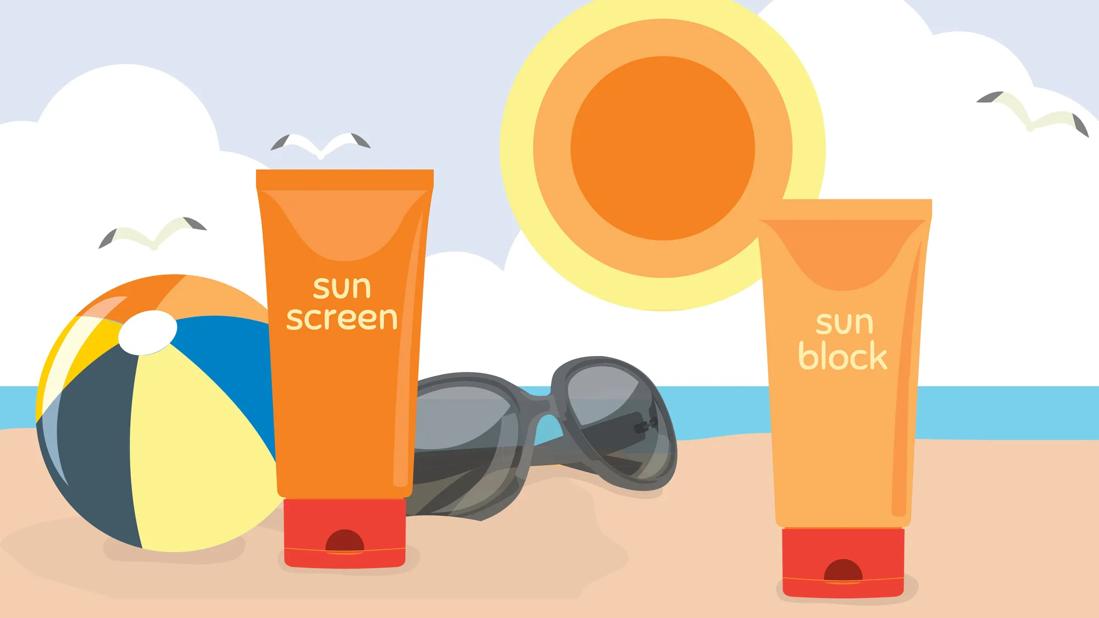Both can protect you from the sun’s rays, but they do it in different ways

When it comes to protecting your skin from the sun, store shelves hold a seemingly endless array of products that can often present more questions than answers. Should you use sunblock or sunscreen? Or maybe both? And what’s the difference anyway?
Advertisement
Cleveland Clinic is a non-profit academic medical center. Advertising on our site helps support our mission. We do not endorse non-Cleveland Clinic products or services. Policy
Dermatologist Shilpi Khetarpal, MD, demystifies sunblock and sunscreen and provides tips for preventing sunburns and sun-damaged skin.
Sunblock and sunscreen take separate routes to accomplish the same job — protecting you from the sun. One functions like a sponge, explains Dr. Khetarpal. The other acts more like a shield.
“Sunscreen is the sponge because it absorbs the sun’s ultraviolet (UV) light and breaks it down to minimize the effect on your skin,” she says. “Sunblock is like a shield because it reflects the UV light, so your skin doesn’t absorb it.”
The ingredients in the products explain how they work differently.
When discussing sunblock and sunscreen, Dr. Khetarpal notes an important caveat: You won’t see the term “sunblock” on products sold in the U.S.
Advertisement
“In 2011, the U.S. Food and Drug Administration (FDA) banned the use of this word on packaging because none of these products actually ‘block’ the sun. Nothing can give you complete sun protection,” she explains.
But many people still refer to certain types of sun protection products as “sunblock” due to their ingredients and the way they work. Check the label for zinc or titanium if you’re looking for sunblock.
Sunblocks and sunscreens both protect you when you’re in the sun. Both can help guard against painful sunburns that can prematurely age your skin and increase the risk of skin cancer.
But one offers slightly better protection. “Mineral sunscreen or sunblock gives more effective sun protection because they reflect UV light,” says Dr. Khetarpal.
Some people prefer sunscreen over sunblock due to its texture, appearance and other factors, though. That’s OK — sunscreen is very effective, and using it is certainly better than putting on nothing at all.
Still can’t decide between sunblock and sunscreen? No problem. You can choose both.
Many sun protection products contain a mix of mineral and chemical ingredients, giving you the best of both. Some prefer these because pure mineral sunscreens often leave a white sheen on your skin.
You may have heard warnings about sunscreens, which may sway your product decisions.
“The FDA has issued warnings that chemical sunscreen ingredients get absorbed into your bloodstream,” says Dr. Khetarpal. “However, we don’t have the research to know if this is bad for your health.”
If you’re worried about absorbing sunscreen molecules into your bloodstream, opt for sunblock with zinc, titanium or both as the only UV-blocking ingredients.
Dr. Khetarpal adds not to use any type of sunscreen or sunblock on children under 6 months. Babies that young should be kept covered up and in the shade. For children 6 to 12 months old, only use mineral sunblock.
Regardless of whether you choose a sunblock, sunscreen or a mix of the two, Dr. Khetarpal recommends products labeled:
Advertisement
If you’re not into smearing or spraying sunscreen on your body throughout the day, you can opt for clothing with a “sunscreen” built in. Clothes labeled with an ultraviolet protection factor (UPF) help protect you from UV light, just like sunscreen.
Be sure to toss on a hat and sunglasses, too, to protect your head and eyes. And even if you gear up, don’t ignore using sunscreen or block — especially on exposed areas like your face, ears and hands.
Advertisement
Learn more about our editorial process.
Advertisement

Several conditions, like vitiligo and fungal infection, can cause a loss of pigmentation, leading to white spots or patches on your skin

This cooling gel can help soothe sunburned skin, but it can’t cure the burn

You know it’s not good if you’ve been holding onto it for more than three years or if it’s changed in color, consistency or smell

Look for a UPF rating of 50+ for optimal protection against UV rays

A sunburn will leave you itchy and red, while sun poisoning can feel like an allergic reaction

A cool shower, aloe vera gel, anti-itch treatments and cool compresses can provide fast sunburn relief

SPF stands for ‘sun protection factor’ — it’s a measure of how much protection you’re getting before a sunburn is possible

This ‘poisoning’ is actually a severe sunburn that seems similar to an allergic reaction

Babies can get congested easily, but you can calm their cough by keeping them hydrated, using nasal drops and running a humidifier

Weight loss may cause loose, sagging skin and muscle loss to your rear

Several conditions, like vitiligo and fungal infection, can cause a loss of pigmentation, leading to white spots or patches on your skin